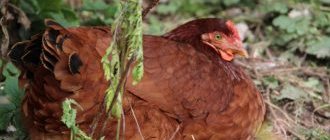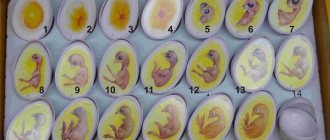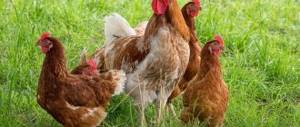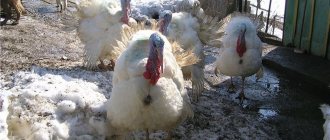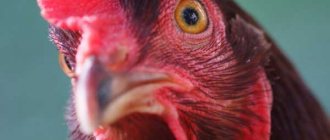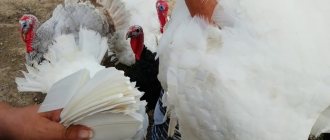Soldering
Chickens cannot be raised without ordinary, clean water, and for chicks it should be provided in small quantities on the first day.
For starters, a 0.5-1 liter jar, inverted into a special drinking bowl with a dispenser, is suitable. It is recommended to feed chickens with a weak pale pink solution of manganese in the first week - this will ensure the prevention of intestinal disorders. For the same purpose, children are given boiled water or diluted decoctions of chamomile, calendula, and yarrow. The drink should not be cold (not lower than 19-20 degrees). Some poultry farmers prefer to immediately treat day-old chicks with antibiotics. This will improve the health of the chicks and avoid many problems. Along with antibiotics, probiotics are also given. This must be done correctly, following the dosages. For questions related to medications and dosages suitable for feeding babies, it is better to consult a specialist.
Vaccination
Vaccination of livestock is a very important process, since many drugs are derived specifically from maternal antibodies. As a result, each chicken receives reliable protection against diseases.
Vaccination, depending on the drug used, is carried out in two ways - by drinking or by injection.
Veterinarians recommend adhering to the following schedule for administering vaccines through water at home:
2 weeks – viral vaccine against Gambor disease. Young animals should not be given water 8 hours before taking the medicine, so it is recommended to remove the drinking bowls in a timely manner. Early in the morning, prepare the drug according to the instructions and give it to the chicks. After 30 minutes, the medicine will no longer be effective, so the liquid is withdrawn. Feeding and water supply can be resumed only after 2 hours. 24 days – revaccination against Gamborova disease
It is carried out in the same way as in the first case, but special attention should be paid to the dosage - mature chickens need more medicine. 27 days – viral vaccine against Newscale disease. The medicine is given through drinking bowls or instilled
Before administering the medicine, feeders and drinkers are taken away from the chickens. They can be returned only after 2 hours.
If there are doubts about the correct dosage, a veterinarian can perform the vaccination. The best option is to call a doctor at home if possible. This is not cheap, but it is suitable for new bird keepers as it ensures that all the steps are followed correctly. By observing a specialist, the young farmer will learn how to carry out manipulations related to the use of medicines in poultry.
Feeding chickens with vitamins and antibiotics, as well as timely vaccination, are mandatory measures that experienced poultry farmers adhere to when feeding chickens.
It should be borne in mind that laying hens have good immunity and their body independently copes with most pathogens, but broilers are weak birds prone to various diseases, so special attention is paid to them when breeding
What to feed chickens
To ensure that the young do not have health problems or developmental delays, the correct diet must be followed immediately after hatching. In the future, the variety of food is gradually expanded, accustoming individuals to adult food.
It is important not only to choose the right products, but also to follow a specific feeding schedule. At first, food is given out every two hours, gradually increasing the interval between meals
At one month of age, the number of feedings should reach three times a day.
First of all, the diet depends on the age of the chicks, so we will consider in more detail what food to give at different periods of development of the young.
DIY food
Properly selected and prepared feed is the key to successful rearing of young animals. In order for the chicks to fully develop, you need to use only fresh and natural products, and it is better to give them out at the same time.
The following products are considered the best food for chicks:
Cottage cheese mixed with fine corn grits in equal proportions; Ground oatmeal, wheat or barley; Low-fat kefir or yogurt serve as a valuable source of protein and calcium, so they are included in the diet within a few days after the chicks hatch; Greens (young nettle, plantain, dandelions, clover or green onions) in crushed form serve as a valuable source of vitamins and beneficial microelements; From the 10th day of life, boiled and fresh chopped vegetables are introduced into the diet; Mineral supplements and small pebbles are also an important part of feeding. They not only stimulate the process of food digestion, but also serve as an important source of microelements. There should be separate feeders for dry and wet food, and when preparing wet mash it is important to strictly observe the proportions
You need to prepare only enough food to eat at one time. If the mash remains in the feeder, the chicks may contaminate it, or the product itself will turn sour and cause poisoning
There should be separate feeders for dry and wet food, and when preparing wet mash it is important to strictly follow the proportions. You need to prepare only enough food to eat at one time.
If the mash remains in the feeder, the chicks may contaminate it, or the product itself will turn sour and cause poisoning.
Poultry farms often practice feeding special feed for chickens. It is not at all necessary to buy it, since you can prepare a similar product yourself (Figure 2).
To prepare, you need to mix the following components (as a percentage of the total mass):
- Corn (50%);
- Wheat (16%);
- Cake (14%);
- Low-fat kefir (12%);
- Barley (8%).
Figure 2. Main components of feed
All grains are thoroughly crushed and mixed with kefir. This feed is used for the smallest chicks that have recently hatched. For older individuals, the list of components is expanded, supplementing it with fish meal, feed yeast, unrefined sunflower oil and fresh chopped herbs.
Chicken diseases
Just like adult chickens, chickens are susceptible to a variety of diseases. Most often they develop the following pathologies.
Hypothermia
– a disease caused by the underdevelopment of the organs responsible for thermoregulation of the body.
Develops against the background of hypothermia and is accompanied by:
- lethargy;
- loss of appetite;
- digestive disorders;
- cough.
Hyperthermia is a pathology that develops as a result of overheating and is accompanied by:
- loss of appetite or refusal to eat;
- digestive disorders;
- intoxication;
- blueness and wrinkling of the scallop (in older chicks);
- taking a lying position, stretching your legs and spreading your wings.
Dyspepsia (indigestion)
– a disease caused by poor nutrition.
Dyspepsia is accompanied by:
- lethargy;
- diarrhea;
- intoxication;
- loss of appetite;
- fever and convulsions (in some cases).
Muscular stomach atrophy
– a disease resulting from the predominance of flour feed in the diet and a lack of calcium components and coarse fibers.
Symptoms:
- thirst;
- weight loss with good appetite;
- constipation;
- the appearance of undigested food in the litter.
Avitaminosis
- a pathology that develops against the background of a lack of vitamins and is accompanied by a deterioration in the condition of the eyes, bones and general well-being of the chicks.
Poisoning
is a condition that occurs due to the ingestion of toxic substances or large amounts of protein in food.
Symptoms:
- lethargy;
- thirst;
- case on legs;
- lowering the wings;
- digestive disorders;
- drawing the neck into the shoulders.
Typhoid is an infectious disease accompanied by:
- apathy;
- whitish diarrhea;
- loss of appetite;
- disheveled;
- half-closed eyes;
- sudden weight loss.
Salmonellosis is an infectious disease characterized by the following symptoms:
- diarrhea;
- unpleasant sensations (the chicks squeak);
- lethargy;
- refusal to rise to one's feet;
- turning the neck to the side.
Pasteurellosis is an infectious disease accompanied by:
- increase in body temperature;
- loss of appetite;
- apathy;
- dulling of plumage and pallor of the skin;
- the appearance of yellowish or greenish mucus in the droppings;
- foamy discharge from the beak;
- blue comb and earrings.
Colibacillosis is an infectious disease whose main symptoms are:
- loss of appetite;
- apathy;
- diarrhea;
- labored breathing;
- cough;
- blue discoloration of the skin, comb, earrings;
- increase in body temperature.
Laryngotracheitis is a viral disease transmitted by airborne droplets and accompanied by:
- apathy;
- opening the beak;
- yawning;
- redness of the eyes;
- coughing up blood;
- blindness.
Flu is a viral disease transmitted by airborne droplets. Symptoms:
- loss of appetite;
- ruffling;
- secretion of mucus from the beak and cloaca;
- increased body temperature;
- diarrhea;
- convulsions.
Newcastle disease is a viral disease accompanied by:
- cough;
- sneezing;
- twisting of the neck;
- the appearance of mucus in the cloaca and nasopharynx;
- bloody, foul-smelling droppings;
- conjunctivitis;
- increased body temperature;
- paralysis
Smallpox
– a viral disease transmitted through household contact.
Symptoms:
- lethargy;
- loss of appetite;
- appearance of vesicles.
– an infectious disease accompanied by:
- greenish droppings, subsequently blood appears in it, and it itself becomes brownish;
- loss of appetite;
- losing weight;
- unsteadiness of gait.
- disorder of the gastrointestinal tract;
- diarrhea;
- losing weight with a normal diet;
- growth slowdown.
Cannibalism
is a condition that develops against the background of a lack of food or crowded conditions in the chicken coop.
It manifests itself in behavior:
- injury to weaker chicks;
- destruction of weak individuals.
What to feed day old chicks
The diet of day-old chicks is already a little more varied. In addition to corn grits, they can already be given:
- semolina;
- barley groats;
- millet;
- ground oatmeal;
- wheat cereal.
Feeding day-old chicks occurs every two hours in small portions so that they do not scatter it. If you give a mixture of different cereals, some chicks may begin to choose the food they like. Therefore, it is better not to mix cereals, but to give them separately. In this case, the porridge is not steamed, but served dry.
Cottage cheese is considered useful
Any dairy products are beneficial for babies. Instead of water, you can pour liquid kefir or fresh whey into the drinking bowl. Curdled milk will provide the chicken’s body with probiotics, and they eat it with pleasure.
On the third day, the chicks can already be fed greens. It could be plantain, dandelion, nettle, midge, clover. Green onions are very useful - they protect the body from intestinal diseases. It is administered only on the fifth day.
If the chickens are broiler chickens, then on the 4th–5th day they are recommended to be given special feed. It contains essential vitamins and minerals for rapid growth and weight gain.
What to feed week-old chicks
Week-old chicks are given a mixture of corn, barley, oat and wheat cereals in a 1:1 ratio. Supplement the food with herbs and dairy products. During this period, the chicks need to be fed less frequently, but in larger portions. Thus, there are 4-5 feedings per day.
What to feed one-month-old chicks
Month-old chicks should already be released for walking, so their diet mainly consists of greens. By eating grass and other greens, they will receive the vitamins needed for their growing bodies. At this age, laying chickens are introduced to coarse grains in their diet. At one and a half months they should already be eating whole grains. You can give bone meal and food scraps.
It is worth taking care of a separate feeder with fine gravel, sand or ground shells. They keep the chickens’ body in normal balance well. If you feed the chicks correctly at home, they grow quickly and do not get sick.
Features of feeding
Laying chickens
Try to immediately accustom the bird to eating greens. This will help you avoid additional costs for vitamins and supplements in the future. After all, fresh greens are a real storehouse of vitamins.
If chickens are kept in an enclosed space, they should be given fish oil for food from 5 days of age at 0.1-0.2 g per chicken. It is advisable to mix fish oil with crushed grain, so it will feed faster.
At the age of one month, young hens should weigh 220-270, cockerels - 290g; at three months - 970-1000 and 1150; at five months of age - 1600-1700 and 1900. Thus, you should control the weight in order to select the strongest individuals.
An approximate diet for egg-laying chickens, g per head per day, is presented in Table 2.
table 2
| Feed | Age of chickens, days | ||||||
| 1-5 | 6-10 | 11-20 | 21-30 | 30-41 | 41-50 | 51-60 | |
| Ground and crushed grain | 4 | 7 | 11 | 18 | 28 | 38 | 45 |
| Cake | — | 0,2 | 0,5 | 0,6 | 1,2 | 1,5 | 2,0 |
| Boiled potatoes | — | — | 4,0 | 10 | 14 | 18 | 20 |
| Cottage cheese | 1 | 1,5 | 2 | 3 | 4 | 4 | 4 |
| Hard boiled eggs | 2 | 2 | — | — | — | — | — |
| Dairy products | 5 | 10 | 15 | 20 | 25 | 30 | 30 |
| Fresh herbs and boiled carrots | 1 | 3 | 7 | 10 | 15 | 17 | 20 |
| Chalk, shell | — | 0,2 | 0,4 | 0,5 | 0,8 | 0,9 | 0,9 |
| Crushed shell | — | 0,2 | 0,4 | 0,5 | 0,8 | 0,9 | 0,9 |
| Ground salt | — | — | 0,05 | 0,05 | 0,08 | 0,1 | 0,1 |
Broilers
Broiler chickens are characterized by a high growth rate, fairly large size and unpretentiousness in feeding. This is why most poultry farmers prefer broilers. In two months, the birds reach 1.4–1.6 kg of weight.
Broiler chickens are usually given a little space. They should not move much, their main task is to gain weight.
Compound feed should be introduced from the second day to 20 g. For the first two weeks, pre-start compound feed is better suited. It contains all the necessary elements for the growth and development of broiler babies. From 14 days onwards, starter feed is suitable, and from one month onwards the birds are transferred to finishing feed. Be sure to read the composition of the feed before purchasing; it should contain only natural ingredients.
From the 5th day it is necessary to introduce vitamins A, D2 and E into the food. Taking vitamins will help avoid many diseases, including rickets. From ten days of age, add chopped carrots to the main food in the amount of 5g per head per day. From two weeks you can replace a quarter of the grain with boiled potatoes; at this age they begin to slowly introduce fish and meat. Don't forget about fermented milk products.
Number of feedings per day:
- in the 1st week – up to 8 times;
- 2nd – 6 times;
- 3rd – 4 times;
- from 1 month – 2 times.
A couple of weeks before slaughter, it is necessary to exclude all additives and gravel from the diet.
When fattening broilers, it should be taken into account that the bird grows faster in the first month if fed dry food rich in protein. A one-month-old chicken should weigh approximately 600-700 g. In the second half of fattening, you can give more vegetables and herbs, and reduce the amount of protein dry food. By the age of two months, a broiler should weigh from 2 kg. To control the weight of birds, weekly weighing is necessary.
How to release chicks
Sometimes you have to help remove half the shell, or even completely, so that the chick can hatch. If the film is not damaged, leave a hole for the beak and return it to the incubator. If it is damaged, when the blood vessels are affected, you need to remove the blood with a cotton swab moistened with a weak solution of potassium permanganate to prevent rotting and infection of the remaining chickens. A drop of blood in the form of beads is not scary, but if there is severe bleeding, you will have to sacrifice one non-viable chick to preserve the health of the others.
Removing the shell is inconvenient at the very beginning. But when you can already penetrate the formed hole with your index finger, it is easier to help hatch. It is necessary, by pressing on the film, to move it a little from the surface of the shell and peel off pieces carefully and slowly.
Occasionally, it happens that twin chicks are born. They are much weaker and usually last longer in the incubator. However, it must be taken into account that after 25 days the chickens are unlikely to be alive.
Feeding and feeding chicks
Chickens from the incubator should be fed with boiled water, which is changed as it gets dirty. Access to water must be constant.
As a means for the rapid formation of microflora, children should be given yogurt (homemade) or biokefir.
If you have fresh whey, it is good to prepare a wet mash of crushed cereals based on it. Also, when using starter feed, you can lightly soak it in whey, but not more than once per day.
Just hatched
The first day after the chicks hatch is an important stage in their development. Therefore, it is necessary to know exactly what to feed chickens from the first days of life at home.
If the chickens are fed incorrectly during this period, this will most likely cause significant mortality (death).
Since not all chickens will immediately peck food, it is best to use crushed cereals: wheat and barley. It will not deteriorate due to the high temperature in the cage, and the babies will not be poisoned.
The chicks should be fed with clean boiled water, into which you can throw a little manganese, but only in such a volume that the liquid does not turn pink.
It is also useful to add a few drops of glucose to the drinker. But fermented milk products should not be given yet. Also, babies should not receive an egg as their first meal.
Daily allowance
Feeding chickens, starting from the first days of life, should be very varied and include not only cereals and dairy products, but also greens and protein foods. Day-old chicks are fed at intervals of 2 hours.
Children are given a mixture of cottage cheese and finely chopped hard-boiled eggs, as well as hard-boiled millet porridge and various crushed cereals.
It is also necessary to provide a sufficient amount of vitamins, for which on the second day you need to offer the chickens chopped green onions (you don’t need to take store-bought ones because of the high content of chemicals in them).
From the 4th day, you should gradually add finely chopped dandelion and woodlice herb to your food. Also, boiled chopped boneless fish and minced beef are being introduced as protein foods. This feeding continues for 7 days.
Dry crushed cereals should be available to the chicks at all times. During the entire period, it is necessary to give babies kefir or yogurt.
Weekly
At the age of 1 week, chicks experience rapid development, which depends on how they are fed during this period.
Week-old babies require the maximum variety of grains at this time. They continue to be given dairy products. The egg can be omitted. It's time for the chickens to sprinkle some coarse sand - it is needed for better digestion of food.
During the same period, small quantities of vegetable and fruit waste begin to be produced (NOT TO BE CONFUSED WITH ROT!).
If you plan to feed with compound feed, you can start adding starter feed.
Two or more weeks
Starting from the age of 2 weeks, if the weather is good, it is time to release the chickens to open ranges.
The diet remains the same, but you can slightly reduce the portion of protein food, since babies will get a fairly large number of insects and worms in the ground.
They will also begin to find greens on their own and do not need to include them in the mash.
Poisonous plants should not grow in areas where chicks roam, since at this age chickens cannot yet distinguish them from edible ones.
Menstruation
From 4 weeks, they begin to gradually transfer chickens, first to medium (coarse) grain, and by 6 weeks - to whole grain.
Once a day they should be given a wet mash with bran, bone meal (it can be replaced with phytocalcivit for dogs), boiled vegetables, and you can also add not very salty table scraps.
In addition, older chickens need to constantly have ground shells for consumption.
If chickens have the opportunity to browse grass unlimitedly, then they do not have to leave grain for the whole day, but can be fed it hourly.
At three months
At the age of 3 months, chickens look like adult chickens and are already transferred to a standard diet, which they will continue to have in the future.
You can feed them by choice: mixed feed or grain mixtures.
How to help chickens hatch and is it worth it?
Nature dictates that future hens and roosters must be born themselves. If the poultry farmer sees that the pecking is taking longer, he can help. It is important to remember such features.
- The hatching process can be facilitated by increasing the humidity inside the incubation chamber. Eggs should be sprayed with warm water.
- If the humidity level is high and the chick cannot peck through the shell, then some make a hole on the side of the air chamber, then tear the film to find the location of the beak.
- When the pipping process is delayed, the chickens are helped in the following way. The poultry farmer makes a crack in the shell in the direction where blood vessels are not visible. This makes further pecking and release easier.
When you decide to help the chickens hatch, the main thing is not to do any harm. Do not damage the shell and subshell membrane in those places where blood vessels are visible. If their integrity is violated, the chicken will not survive. When the shell is mechanically broken, the inner film is not broken. You need to wait until she goes away on her own.
Important! At low humidity, the film may dry to the body. You can't tear it off. Experienced farmers recommend moistening the area with water and using a cotton pad to clean the body.
If the process of releasing the embryo is accompanied by bleeding, then it has little chance of survival. It is not advisable to place such an egg back into the incubator. Released blood may lead to the spread of infection within the incubation chamber.
In cases where the biting was completed successfully, you should find out what to do with the resulting offspring.
Relocation of chickens to the poultry house
When planning to place chickens in brooders or cages, disinfect the agricultural premises and prevent fluffworms.
To disinfect the poultry house, use Biodez-R or Virkon-S. A 2% solution of these drugs is suitable.
Biodez and Virkon-S
After treating the room, do not open the doors for half an hour, then ventilate the chicken coop well. As soon as the disinfectants have evaporated, use Butox to prevent external parasites (prepare an aqueous solution in a 1:2 ratio).
Butox
Ventilate the room again for 5 hours.
What to feed day old chicks
Some farmers are confident that after birth, the chicks replenish energy losses with the remains of the yolk, so they do not need additional feeding. Others believe that feeding the baby after hatching is simply necessary. The fact is that chickens digest the remains of the yolk at different rates, it all depends on the characteristics of the body.
Important! After digestion of the yolk, the chicken must eat for normal formation of the digestive tract. Feed regimen for young animals from birth to 1 month (day):
Feed regimen for young animals from birth to 1 month (day):
- 1 week – 8 times;
- from 10 to 30 days – 6 times.
Interesting! A novice chicken breeder should ask what to feed newly hatched chickens. Proper feeding of chickens in the first days of life at home will help preserve the lives of tiny chicks.
When asked what to feed newborn chickens, experienced farmers answer that the very first food should be prepared with your own hands. Namely, hard boil one egg, then finely chop its yolk. You can add carefully ground shells and a little semolina (so that the yolk does not stick together). Then you can supplement the menu with kefir (fresh). It will help the formation of healthy microflora in the intestines and will contribute to good digestion of the chicks.
On a note! A good food for newborn chicks is corn grits, as it is small and easy for babies to peck at.
The diet of a one-day-old chick is more varied. Now he can eat millet, chopped oat flakes, crushed wheat, and barley groats.
Day old chicks should eat small portions every 2 hours. There should be enough food, but not in excess, so that the kids don’t throw it away.
Important! Cereals for chickens are not boiled or steamed; they are given strictly in dry form. In a couple of days, cereals alone will not be enough to feed the birds.
We need to think about what to feed day-old chicks additionally
In a couple of days, cereals alone will not be enough to feed the birds. We need to think about what to feed day-old chicks additionally.
Cottage cheese should be included in the diet of chickens, as it is rich in calcium. It is better to give it in the morning, mixing it with cereals. All dairy products are very beneficial for a growing chicken; they will saturate its body with probiotics.
Important! The only exception is fresh milk - it upsets the chickens’ digestive system. On day 3, you need to include greens in your diet: plantain, clover, nettle and midge
This will protect the chick’s delicate body from various types of intestinal diseases.
On day 3, you need to include greens in your diet: plantain, clover, nettle and midge. This will protect the chick’s delicate body from various types of intestinal diseases.
On day 5, you can include green onions, zucchini and carrots in the chicken menu. From this age, you can also give meal, cake and minerals. Broiler chicken can be given special feed from 3-4 days. At this stage, the farmer should already take care that young animals for meat production begin to grow quickly and gain weight.
Many poultry farmers prefer to give special nutritious food for chickens during this period - “Purina” or “Solnyshko”, for better growth
This mixture contains all the necessary grains, microelements and vitamins. It is important to correctly calculate the serving size so that the kids do not go hungry or overeat. After all, well-fed chickens can pick at their food out of curiosity, in case they find something tasty
Therefore, farmers must know how many grams are due per chicken per day.
Recommended feeding rates for egg breed chicks from 0 to a month
| Diet | Age of chicks, in days | |||
| 01.03.2018 | 04.10.2018 | 01.11.2020 | 21-30 | |
| Boiled egg | 2 | 2 | – | – |
| Curdled milk | 5 | 8 | 15 | 20 |
| Cottage cheese | 1 | 1.5 | 2 | 3 |
| Groats | 5 | 9 | 13 | 22 |
| Fish flour | – | – | 1 | 1.4 |
| Meal, cake | – | 0.2 | 0.5 | 0.6 |
| Greens, carrots | 1 | 3 | 7 | 10 |
| Boiled potatoes | – | – | 4 | 10 |
| Minerals | – | 0.4 | 0.7 | 1 |
Poultry farmers often ask what to feed chickens in the first days of broiler farming. The farmer should take care that young animals for meat production begin to grow quickly and gain weight. The answer is simple - you need to feed broilers with compound feed.
Just remember that the water:feed ratio should be 1.7:1. The water temperature should be 18-22 degrees C.
| Prestart | Start | Fattening | Finish | |
| Age | 0-5 | 01.06.2018 | 19-37 | Z8-42 |
| Norm (gram) | 15-20 | 25-88 | 93-127 | 160-168 |
Signs of impending hatching
According to the rules, 3 days before the upcoming hatching you should stop turning the eggs. At this time, the chicks are already fully formed, the protein has been consumed and the process of retracting the yolk is underway. In recent days, it is necessary to monitor the temperature, increase the humidity as much as possible and ensure access of oxygen to the incubator.
You can understand that the chicks will soon begin to hatch during ovoscopy. It is carried out on days 18-19. There should be no gap at the pointed end; at the blunt end, the air chamber should be clearly visible. The chicks occupy all the space, so the border of the air chamber will be uneven. Sometimes the movements of the chicks are noticeable, as they try to stick out their necks.
Ovoscoping of hatching raw materials
Prices for ovoscope
Signs of impending hatching include:
- a faint squeak under the shell, which can be heard by placing your ear to the surface of the egg;
- quiet characteristic tapping: it indicates that the pecking process is beginning;
- movements: eggs that lie on a flat surface may wiggle slightly, this indicates that the chicken inside is actively moving.
Caring for day old chicks
Before moving into the poultry house, newborn broilers must be kept in a clean, bright place at a temperature of about 30°C for several days. A corrugated cardboard box with an incandescent lamp suspended 50–60 cm above the bird’s heads is quite suitable for this.
Chicks that appear sick should not be housed in a communal box. They may have an infection and pass it on to others.
About 40% of purchased individuals may die if they are not given medications on time.
Newborn broilers are fed like regular chickens. Suitable for feeding:
- boiled eggs;
- crushed wheat;
- millet.
Feeding day old chicks with yolk
On the third day, crushed greens rich in vitamins are added to the chicken feed mixture (mash).
The chicken has hatched from the egg: what to do next?
Usually the entire brood appears within a day. The chickens must spend the first few hours in the incubator, where they dry out and gain strength after the labor-intensive pecking. The dried chicks are taken out of the incubation chamber and placed in a pre-prepared box or basin.
Warming up in the incubator
Prices for egg incubators
You can put a heating pad on the bottom, and install a regular incandescent lamp or a blue lamp on top so that the kids cannot reach it. If the chicks are cold, they huddle in the area of the heat source. The bottom of the prepared container is covered with cloth.
Chickens that are completely dry are offered water and feed. At first, their appetite may be weak. This does not indicate any health problems. Most likely, the nutrients from the yolk have not yet been fully absorbed.
Raising chickens can be challenging for new poultry keepers. Let's look at approximate diets for meat and egg chickens depending on age. Keeping chickens from the first days of life.
Growing and caring for broiler chickens
Broiler chickens are advantageous because they gain live weight fairly quickly, and their carcasses are large in size, so you can get a lot of dietary meat from a small flock.
At the same time, raising such breeds has its own characteristics, which differ in many respects from keeping laying hens.
Conditions of detention
Raising broilers for meat is a fairly profitable business if you properly prepare the premises and equipment for the poultry:
- Broiler chickens can be raised simply on litter, but it is better to keep them in special cages. This way the birds will not spread food and garbage.
- To raise broiler chickens several days old, you will need brooders. These are boxes with heating lamps, bedding, feeders and drinkers. Older chickens also require containers for food and water.
- Feed: Productive rearing of broiler chickens involves the use of balanced feeds rich in proteins, vitamins and minerals. In winter, it is rational to feed commercially produced feed.
Table 2. Example of a diet for broilers
Since raising broiler chickens involves obtaining meat, there is no need to equip a large run for the birds. They can be kept in cages with mesh floors.
If you plan to breed chickens for meat, it is better to choose a meat broiler breed, since already at two months of age the weight of one individual can reach one and a half kilograms (Table 2).
How to leave chickens for the winter, preparation
By the beginning of September
you will know how many hens have grown and how many cockerels. If you leave hens for breeding, you need to select the largest and strongest rooster for them and transfer them to a room equipped for keeping poultry in winter. Feeders, a box, and parts of the arena are washed, dried in the sun and put away in the barn until next spring.
Leave the chickens for the winter.
Some advice for those who leave chickens for the winter. In mid-June, do not forget to prepare hay and twig food (brooms). Place the grass cut in the morning, or even better, clover, on a rack of slats (thick rods) in the shade in a layer of 15-20 centimeters. Drying in the shade will preserve beneficial nutrients. Turn the grass 2-3 times during the day. After 3-4 days, the hay is stored. Brooms are prepared from branches of yellow acacia (preferably), birch and linden before July 15. Cut branches up to 80 centimeters long are tied in 8-10 pieces and hung under a canopy in the shade. After 5 days, the brooms can be put (preferably hung) for storage.
For one bird left for the winter, up to 8 kilograms of hay and up to 20 brooms should be prepared. This will be an excellent vitamin supplement to the feed.
I wish you success.
N. Kashin. Moscow region
» Chickens
People decide to raise poultry at home for three reasons:
- Fresh eggs
, rich in nutrients, are always available - for personal consumption of dietary meat
; - for the purpose of selling surplus
eggs and meat.
Ways and methods of its breeding
are also different.
You can collect eggs from laying hens and put them in an incubator, or buy eggs and incubate them. A very common option is to purchase a brood of chickens and then raise
. Read below how to feed chickens and care for them in the first days of life.
In the first days, newborn chicks are kept in a cardboard box.
.
Then they are transplanted into special cells. You can immediately raise chicks in cages. Requirements for living conditions:
air temperature in the first days of life is above 27 degrees, then it is gradually lowered (month-old chickens can be set at 20 C);
humidity
– around 70%;
protect your chickens from drafts and dampness; give only high-quality food
and clean
water
(we’ll talk about nutrition below);
increased daylight hours (with age it gradually decreases to normal daylight hours); keep the growing area clean; It is advisable to provide ventilation
;
the room should be sufficient for free eating (if these are not broiler chickens, they can be kept in a more spacious room); make sure that the feeders
are clean, give porridge in separate feeders or make a partition in one;
the drinking bowl
according to the age of the bird, making sure that the chicken does not choke in it.
If hatching chicks are kept in a pen
, then their care is the same as when grown in cages.
Particular attention should be paid to the bedding on the floor
. To avoid illness, it must be dry, and the floor must be warm. Due to the fact that the total area of the pen is larger than the total area of the cage with the same number of birds, make sure that the feeders and waterers are positioned in such a way as to prevent them from tipping over on the chicks.
What to feed and drink?
Placing the chickens in a warm and well-lit place is half the battle. Babies need a proper diet literally from the first days, and that’s exactly what we’ll talk about later.
Immediately after hatching
Once you have removed the babies from the incubator, let them dry. The first food for chickens after hatching is provided by nature: the newborn chicken receives a certain supply of energy from the residual yolk. It is advisable to carry out the first feeding no later than 12-16 hours after hatching. It has been proven that chicks that receive the first portion of food at this time will show better productivity in the future. Compared to their brothers, who spent the first hours of their lives on a starvation diet.
In addition, when a chicken pecks and swallows something for the first time in its life, this will trigger the formation of a proper digestive system in its tiny body. For quite a long time, crushed chicken yolk was considered the ideal first food for chickens. However, recent studies have refuted this argument, declaring that the yolk is too fatty food for the tender chicken gizzard. There is a reason for this, because the yolk really consists for the most part of fats, but at the same time it does not put the necessary load on the digestive organs.
For feeding chickens only from the incubator, this will be quite enough. It is not recommended to drink newborn chicks with anything other than purified water. In fact, the little chicken is still sterile; there is neither beneficial nor harmful microflora in its intestines. And drinking potassium permanganate in the first hours of life, as some breeders do, is unjustified.
What can really be useful for a newborn chick is a glucose solution. It carries a powerful energy charge and prevents anemia in chickens.
Daily allowance
When the chickens are one day old, in addition to corn grits, a mixture of cereals is introduced into their diet: semolina, wheat, barley, millet. You can also give starter feed specifically for day-old chicks; it has small granules and is successfully eaten by miniature eaters. Day-old chicks at home are fed every 2 hours, observing the regime; at night you also need to monitor and care for the babies. Be sure to check the fullness of each goiter and remove those day-old chicks that turn out to be hungry; they need to be given food separately. And then in the video an experienced breeder shares his experience of keeping them.
It is advisable to pour yogurt into the drinking bowls - the best natural probiotic. It will also be useful to drink kefir, but you should refuse milk, it is not absorbed by day-old chicks. If your charges are capricious and do not want to drink milk on their own, you will have to feed them with a pipette. This, of course, is a little troublesome, but babies need such careful care only in the first days of life.
From two days to seven days of age
So, your birds are gradually getting stronger and gaining strength. At the age of 2 to 7 days, they are still very tender and require your special care. You need to feed them often at this time, as we have already said, every 2-3 hours. But by the end of the first week, the number of feedings gradually decreases to 5-8 times. As for portions, there is no need to particularly limit the kids, they spend almost all their time eating, the main thing is to monitor the fullness of their goiters.
An approximate portion of food for a chick aged 3-7 days is 10 g of food. Its qualitative composition is also beginning to change little by little. From the third day of life, the diet of feathered babies should include finely chopped greens. It is best to give yellowthroats nettle, dandelion, and clover. The grass needs to be washed well, you can scald it with boiling water, chop it finely and mix it with cereal or cottage cheese.
After this, from the fifth day of life, chopped green onions are also introduced into the diet. It is administered for medicinal purposes - this greenery is a prevention of intestinal diseases.
Also, at a week old, chickens can already eat porridge and mash with the addition of grated potatoes or carrots. We do not exclude dairy products for now, but we reduce their portions; it is advisable to give them yogurt until they are a week old. As for medications or vitamins, they are not recommended to be given before one week of age. In principle, if you feed the chicken fully, then it will get all the nutrients and vitamins from the food.
